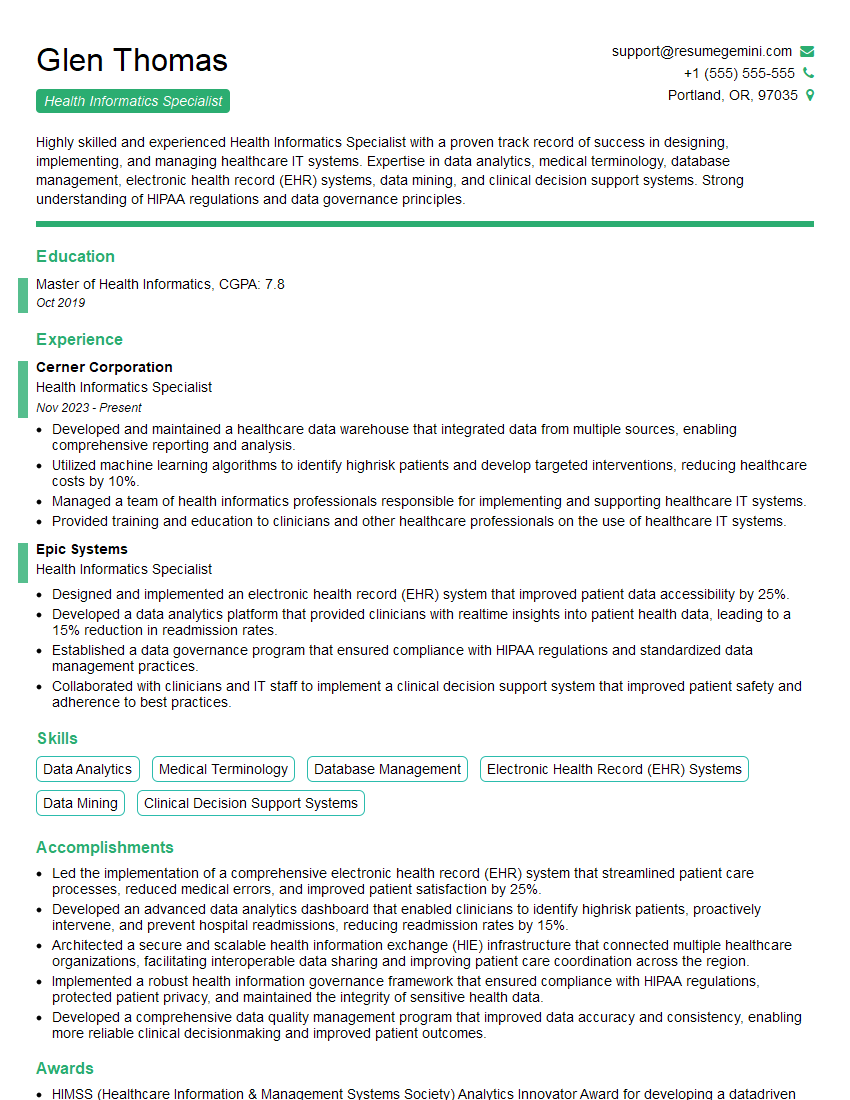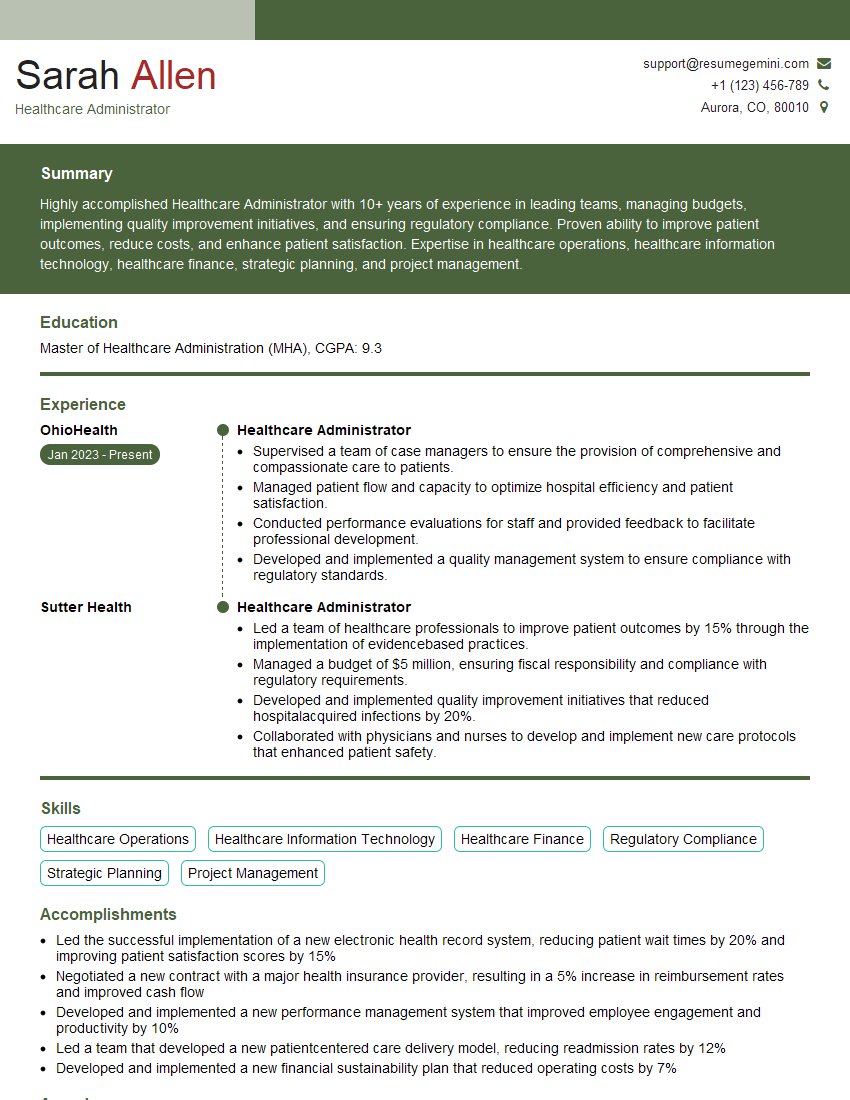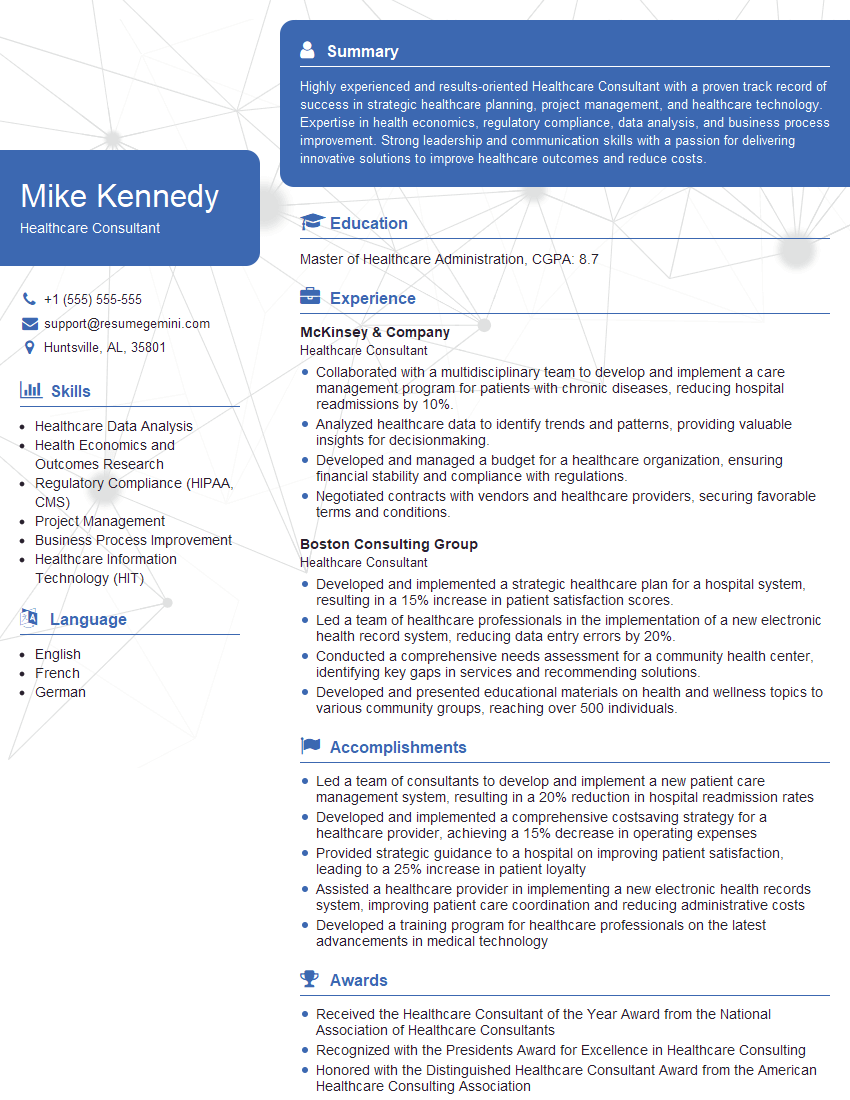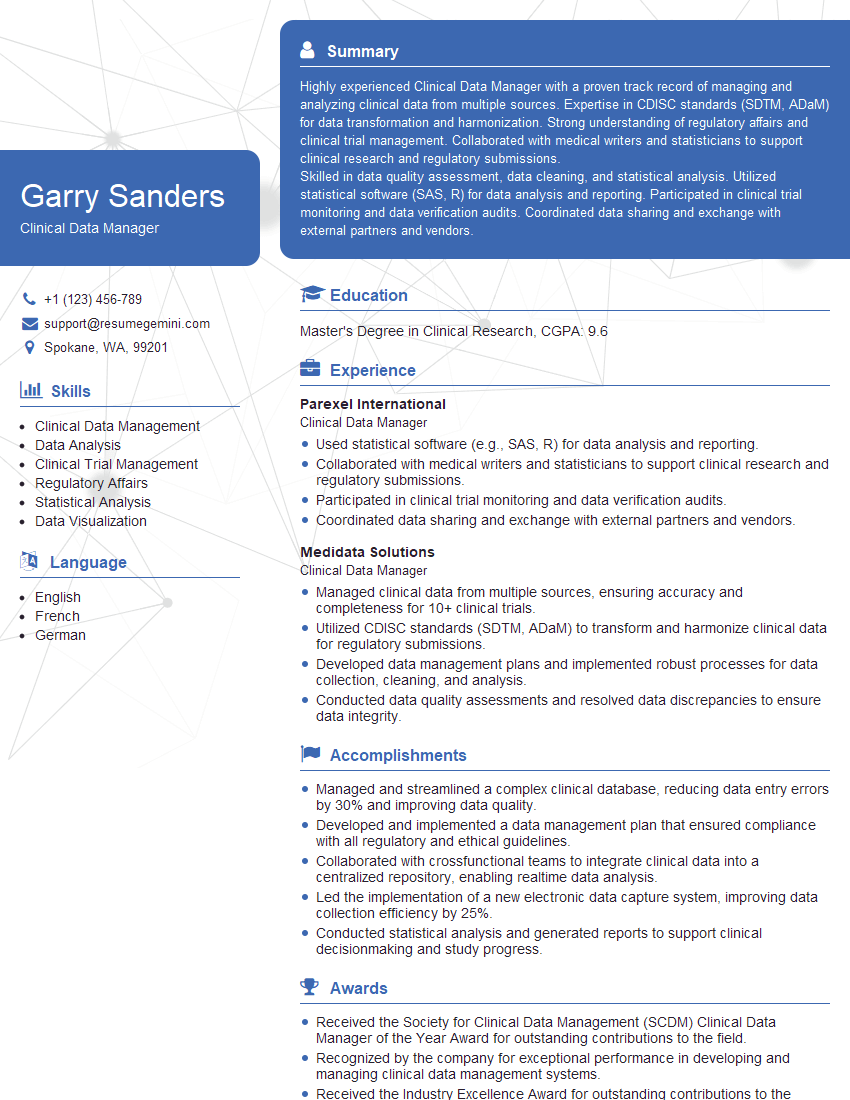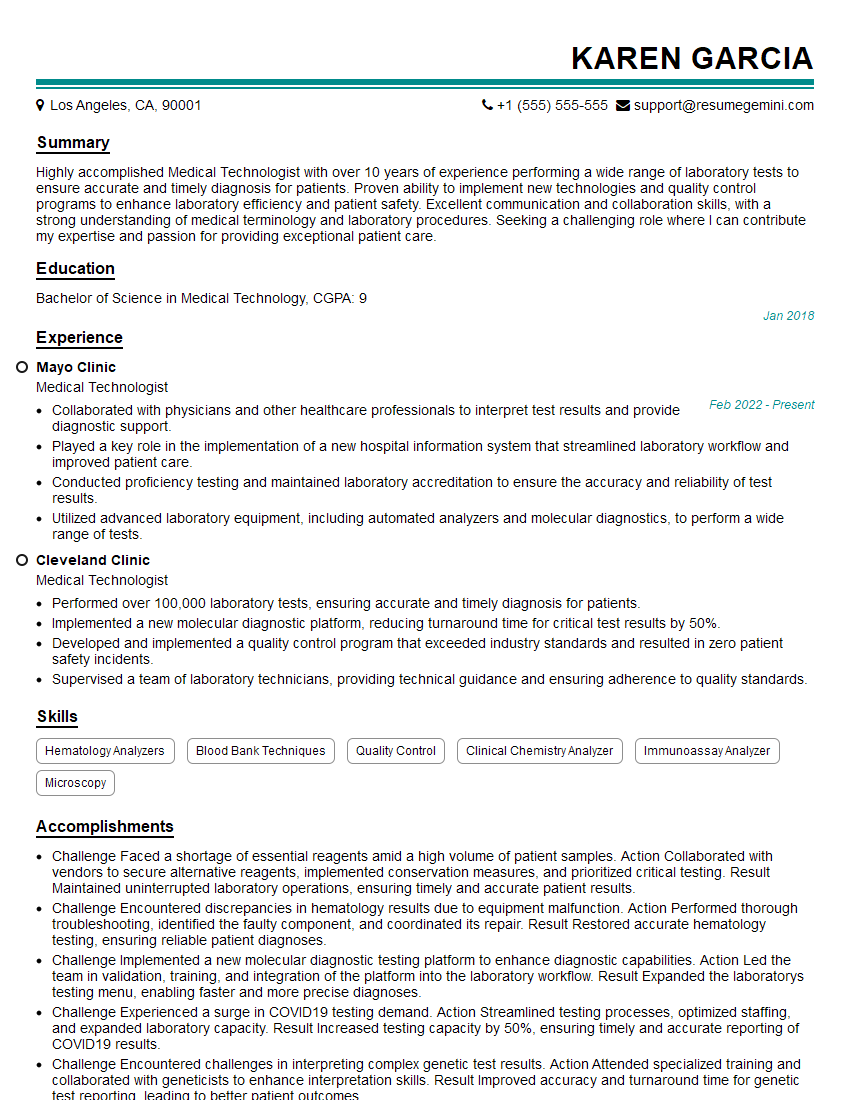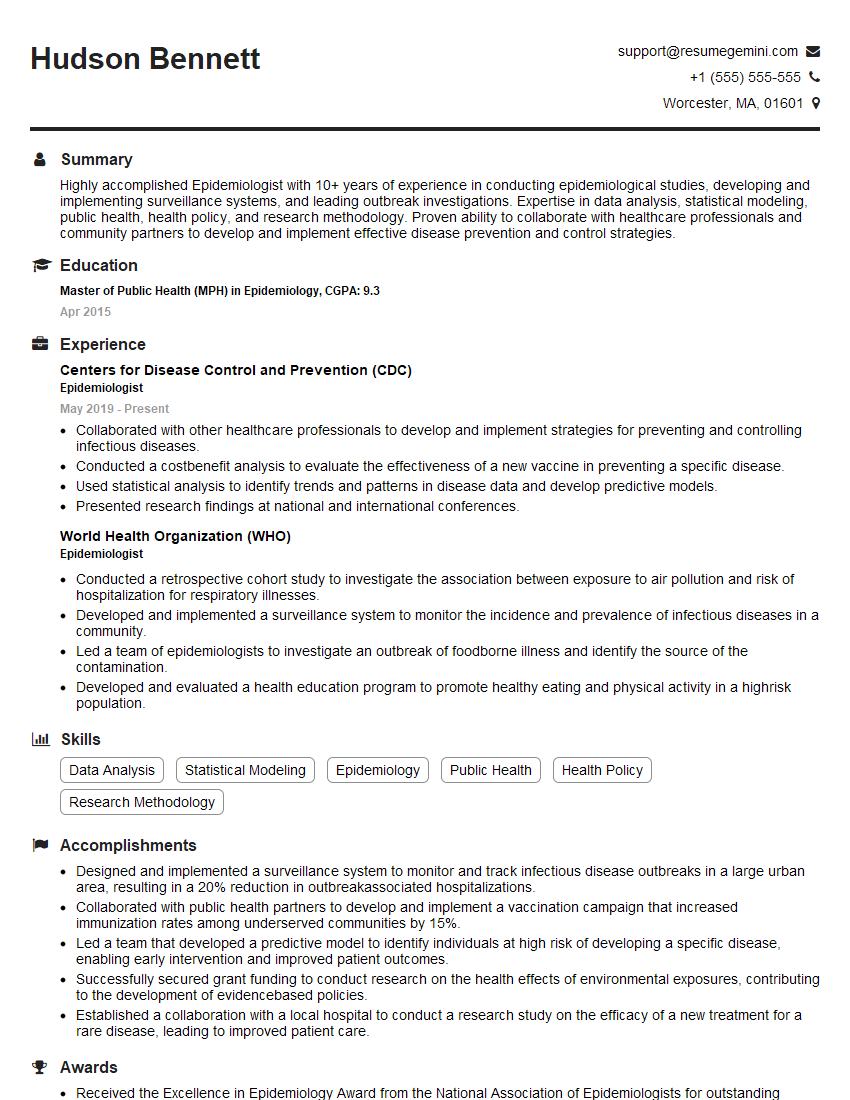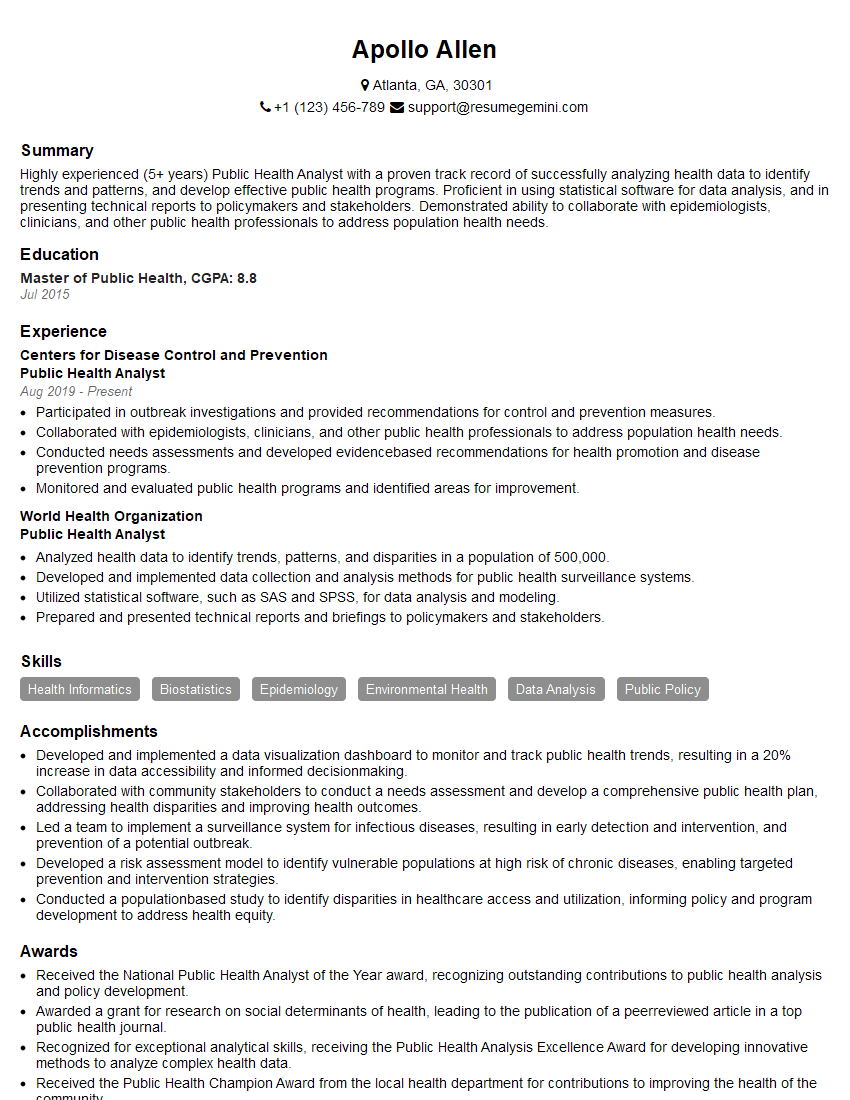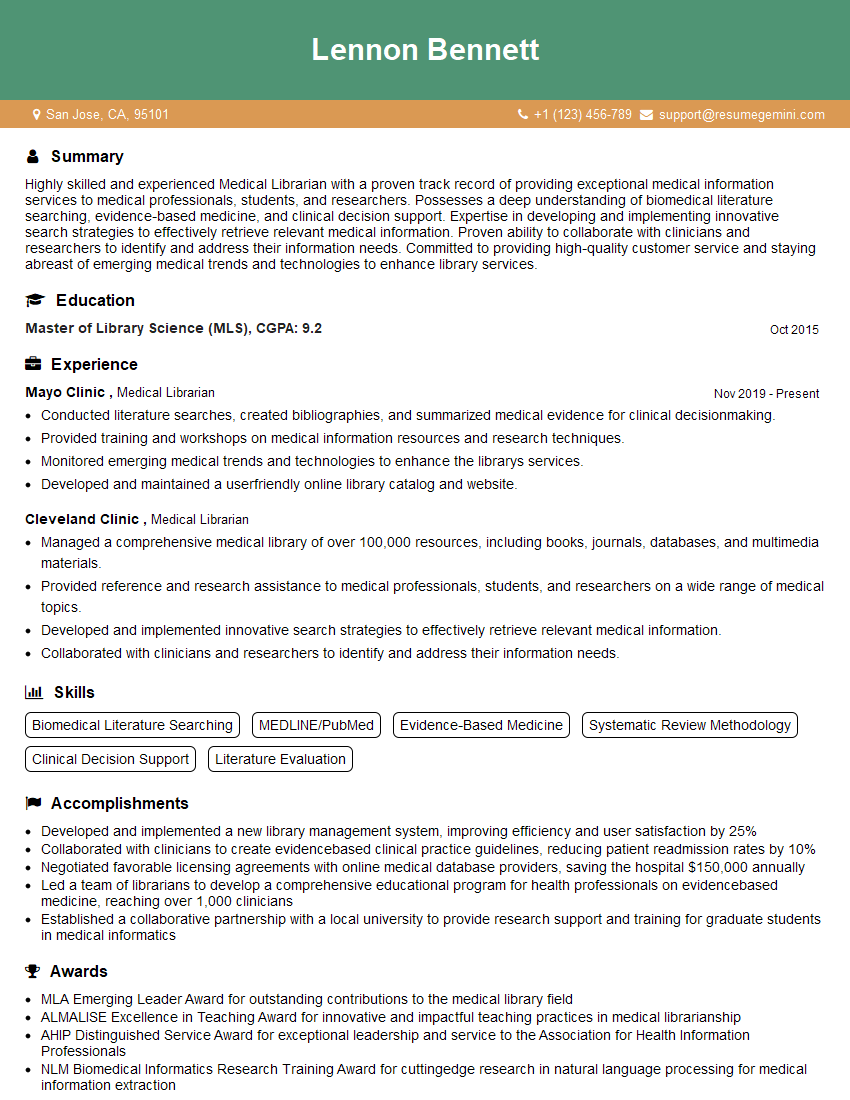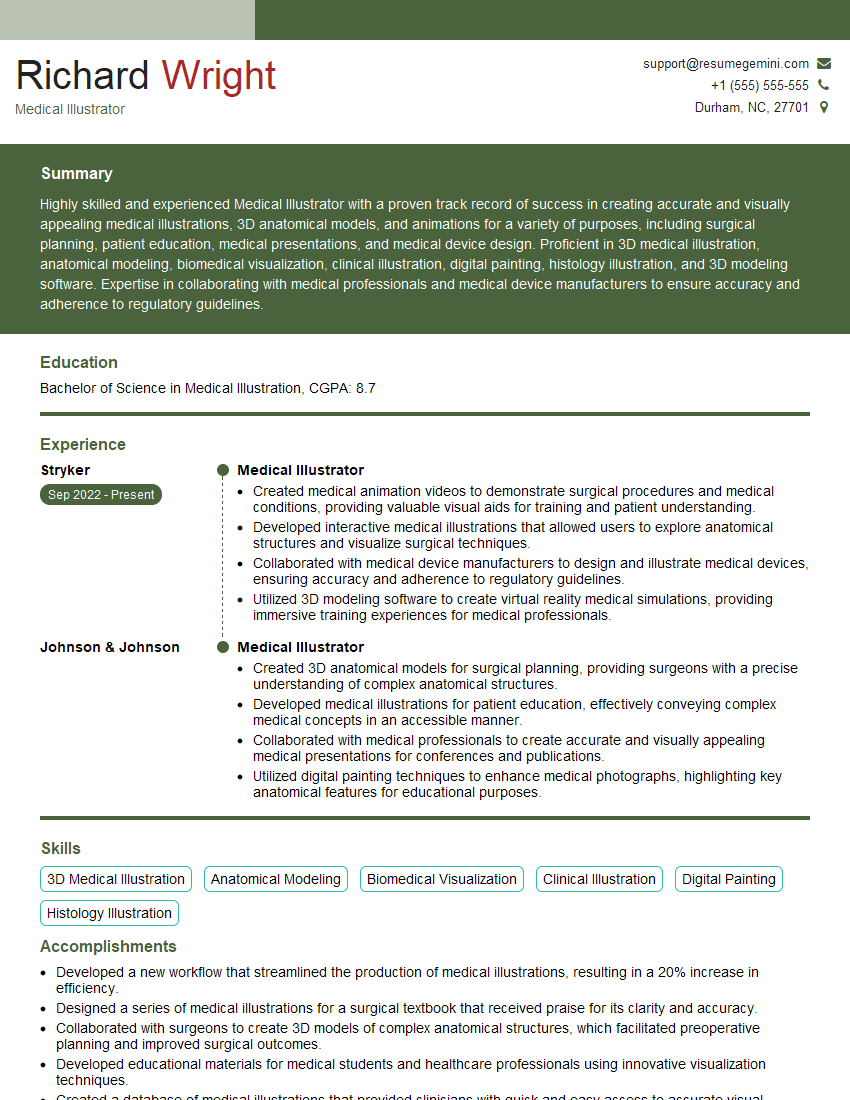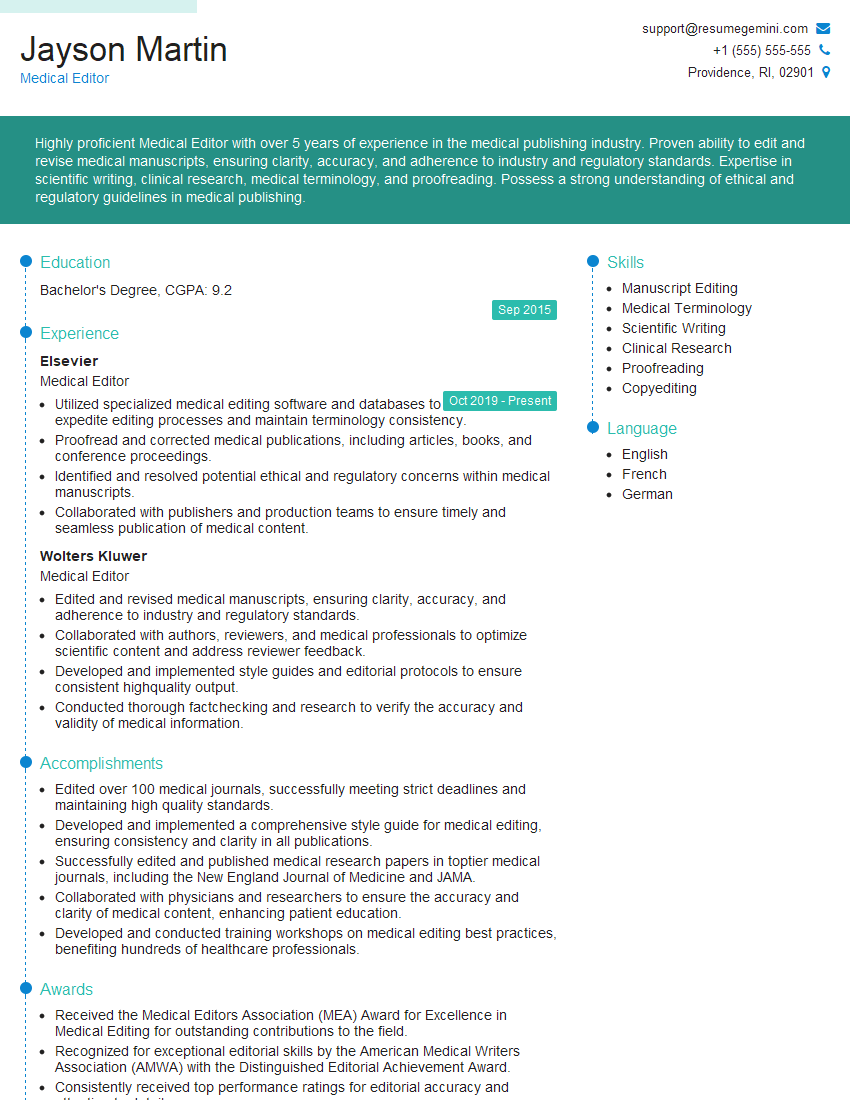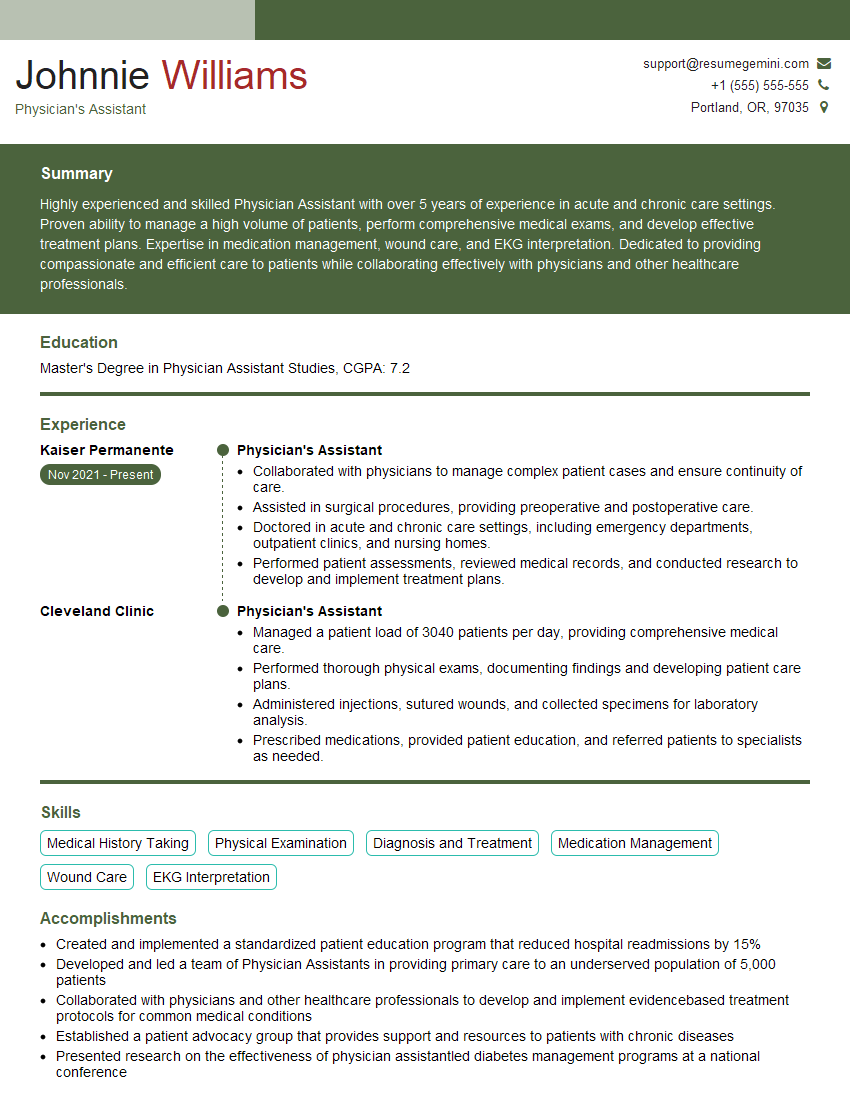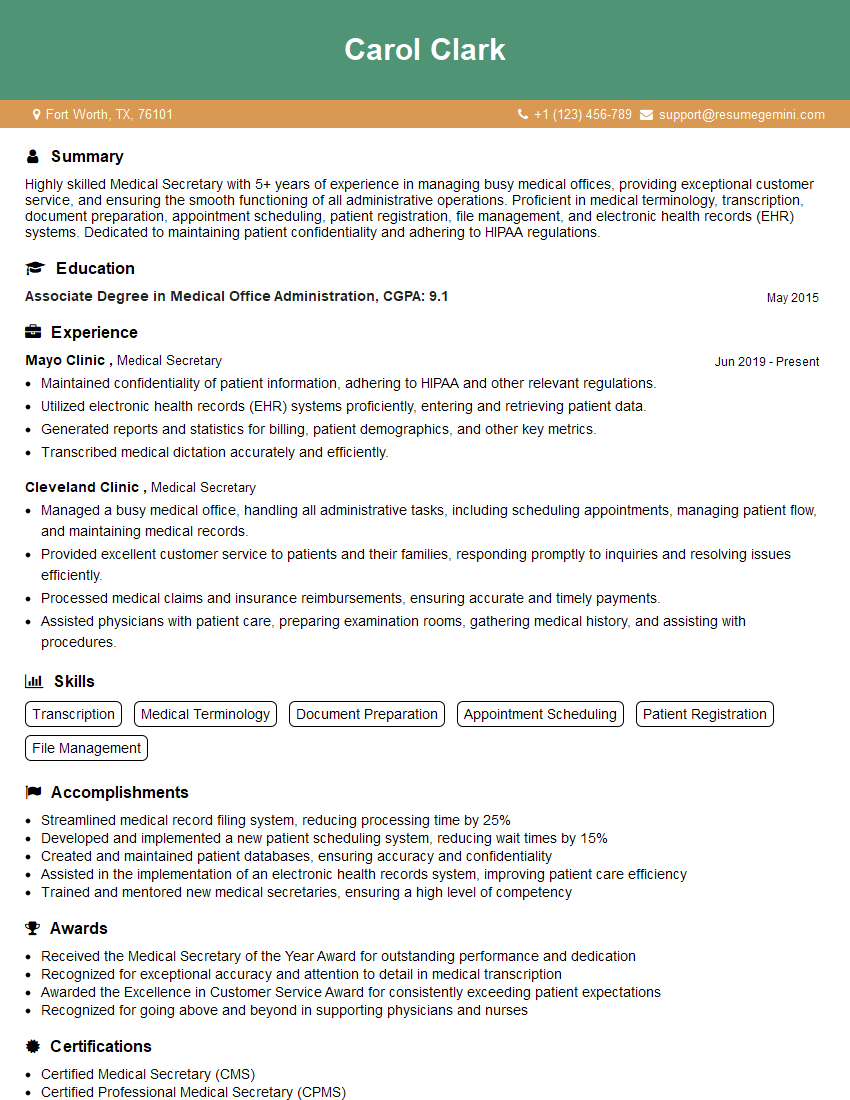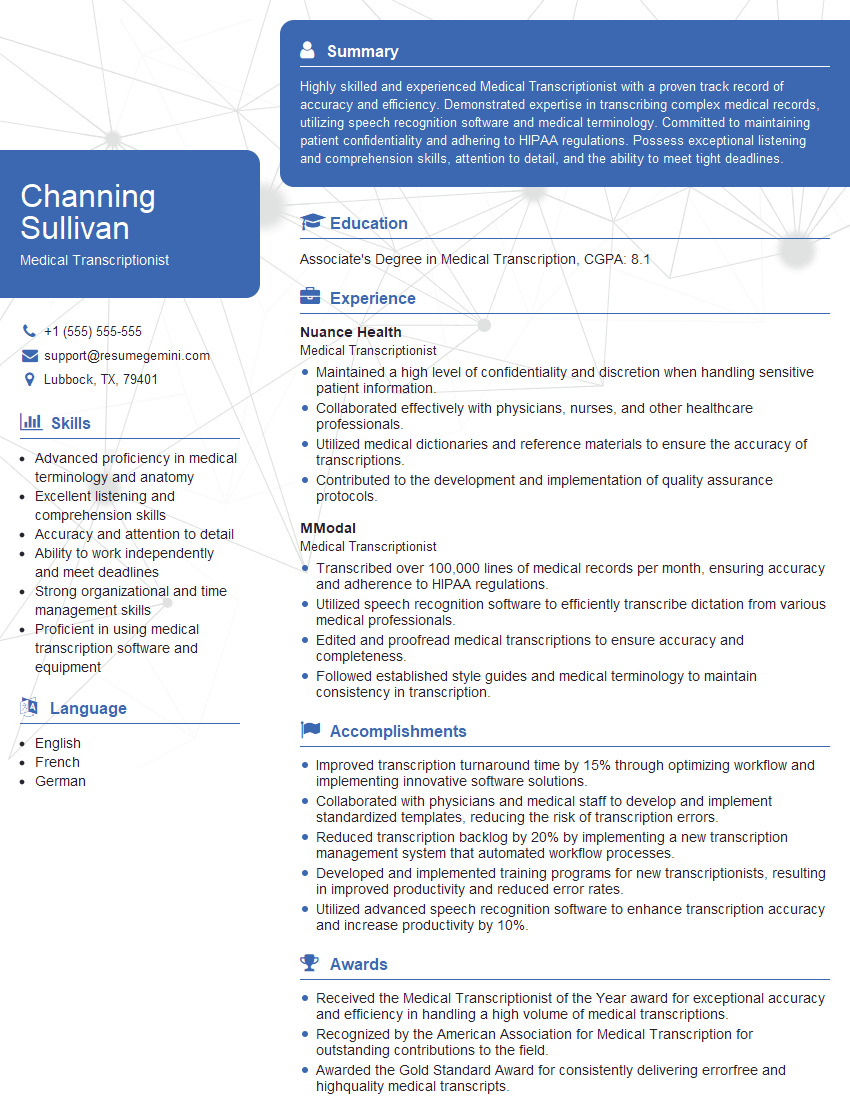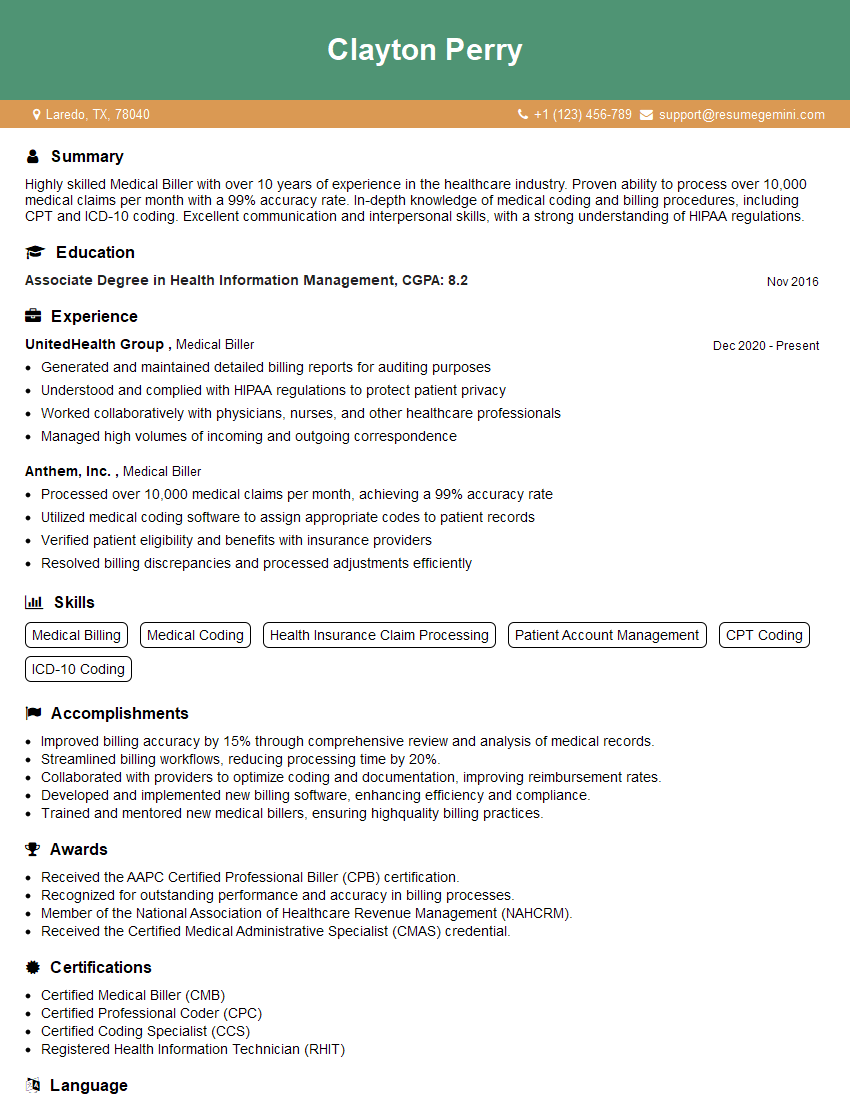Cracking a skill-specific interview, like one for Working knowledge of medical terminology and scientific principles, requires understanding the nuances of the role. In this blog, we present the questions you’re most likely to encounter, along with insights into how to answer them effectively. Let’s ensure you’re ready to make a strong impression.
Questions Asked in Working knowledge of medical terminology and scientific principles Interview
Q 1. Define ‘iatrogenic’ and provide an example.
Iatrogenic refers to a disease, condition, or injury that is caused by medical examination or treatment. Think of it as an unintended negative consequence of medical intervention. It’s literally ‘doctor-caused’ (from Greek iatros, meaning ‘physician’ and -genic, meaning ‘producing’).
Example: A patient develops a hospital-acquired infection (HAI) after undergoing a surgical procedure. The infection, though not the intended outcome of the surgery, is considered iatrogenic because it resulted from the medical setting and treatment. Another example could be nerve damage during a surgical procedure, resulting in loss of function.
Q 2. Explain the difference between ‘diagnosis’ and ‘prognosis’.
Diagnosis is the process of identifying a disease or condition based on an evaluation of the patient’s symptoms, medical history, physical examination, and diagnostic tests. It’s essentially figuring out what is wrong.
Prognosis, on the other hand, is a prediction of the likely course of a disease or condition and the chances of recovery. It focuses on what will likely happen to the patient given their diagnosis and other factors.
In short: Diagnosis answers ‘What is the problem?’, while prognosis answers ‘What is the likely outcome?’
Q 3. What is the meaning of ‘etiology’ in a medical context?
In medicine, etiology refers to the cause or origin of a disease or condition. Understanding etiology is crucial for effective treatment and prevention. It encompasses identifying the factors that contribute to the development of a particular health problem, which can range from genetic predispositions and environmental exposures to infectious agents and lifestyle choices.
Example: The etiology of lung cancer might include smoking (a major risk factor), exposure to asbestos (environmental factor), and a family history of lung cancer (genetic factor).
Q 4. Describe the process of cellular respiration.
Cellular respiration is the process by which cells break down glucose and other organic molecules to release energy in the form of ATP (adenosine triphosphate), the cell’s primary energy currency. It’s a series of complex biochemical reactions that occur in three main stages:
- Glycolysis: Glucose is broken down into pyruvate in the cytoplasm.
- Krebs Cycle (Citric Acid Cycle): Pyruvate is further oxidized in the mitochondria, generating ATP, NADH, and FADH2.
- Electron Transport Chain (Oxidative Phosphorylation): Electrons from NADH and FADH2 are passed along a chain of protein complexes in the mitochondria, generating a proton gradient that drives ATP synthesis.
Think of it like burning fuel (glucose) in a car engine to generate power (ATP) to run the car (cell). The whole process requires oxygen, making it an aerobic process.
Q 5. What are the key components of the Krebs cycle?
The Krebs cycle, also known as the citric acid cycle or tricarboxylic acid (TCA) cycle, is a central metabolic pathway in all aerobic organisms. Its key components are:
- Acetyl-CoA: The starting molecule, derived from the breakdown of pyruvate (from glycolysis) and fatty acids.
- Citrate: The first intermediate molecule formed in the cycle.
- Oxaloacetate: A four-carbon molecule that regenerates at the end of the cycle to accept another acetyl-CoA.
- NAD+ and FAD: Electron carriers that are reduced to NADH and FADH2, respectively, carrying high-energy electrons to the electron transport chain.
- Enzymes: Several specific enzymes catalyze each step in the cycle.
The cycle produces ATP, NADH, and FADH2, which are crucial for energy production in the electron transport chain.
Q 6. Explain the difference between mitosis and meiosis.
Both mitosis and meiosis are types of cell division, but they have distinct purposes and outcomes:
- Mitosis is a type of cell division that results in two daughter cells, each having the same number and kind of chromosomes as the parent nucleus, typical of ordinary tissue growth.
- Meiosis is a type of cell division that results in four daughter cells each with half the number of chromosomes of the parent cell, as in the production of gametes.
Essentially, mitosis is for growth and repair, producing identical copies of cells. Meiosis is for sexual reproduction, creating gametes (sperm and egg cells) with half the genetic material, ensuring that when they combine during fertilization, the resulting offspring has the correct number of chromosomes.
Q 7. Define ‘homeostasis’ and its importance in the human body.
Homeostasis is the body’s ability to maintain a stable internal environment despite changes in the external environment. Think of it as the body’s internal thermostat, constantly working to keep things balanced. This involves maintaining stable levels of various factors such as:
- Temperature: Keeping body temperature around 98.6°F (37°C).
- pH: Maintaining a relatively constant blood pH (around 7.4).
- Blood glucose: Regulating blood sugar levels.
- Fluid balance: Maintaining appropriate fluid levels.
Maintaining homeostasis is critical for survival because cells and tissues function optimally only within a narrow range of conditions. Dysregulation of homeostasis can lead to disease and even death.
Q 8. What is the function of the endocrine system?
The endocrine system is a complex network of glands that produce and release hormones directly into the bloodstream. These hormones act as chemical messengers, traveling throughout the body to regulate a wide range of physiological processes. Think of it as a sophisticated communication system using chemical signals instead of electrical ones.
Its primary function is to maintain homeostasis, or internal balance. This includes regulating metabolism, growth and development, reproduction, mood, sleep, and many other vital functions. For example, the thyroid gland produces hormones that control metabolism, while the pancreas releases insulin to regulate blood sugar levels. Imbalances in the endocrine system can lead to a variety of disorders, from diabetes to growth disorders.
- Regulation of Metabolism: Hormones like thyroxine (T4) and triiodothyronine (T3) from the thyroid gland influence the rate at which the body uses energy.
- Growth and Development: Growth hormone from the pituitary gland is crucial for childhood development, while sex hormones from the gonads influence puberty and sexual characteristics.
- Stress Response: The adrenal glands release cortisol and adrenaline in response to stress, preparing the body for ‘fight or flight’.
Q 9. Describe the structure and function of the nephron.
The nephron is the functional unit of the kidney. Imagine it as a tiny, highly efficient filtration system within the kidney. Each kidney contains millions of nephrons, responsible for filtering blood and producing urine.
Structure: A nephron consists of two main parts: the renal corpuscle and the renal tubule. The renal corpuscle comprises the glomerulus, a network of capillaries, and Bowman’s capsule, a cup-like structure surrounding the glomerulus. The renal tubule is a long, twisted tube divided into the proximal convoluted tubule, the loop of Henle, and the distal convoluted tubule. The distal tubules from multiple nephrons then empty into collecting ducts.
Function: The nephron’s primary function is to filter blood and remove waste products, regulate fluid balance, and maintain electrolyte homeostasis. This occurs in a series of steps: filtration, reabsorption, and secretion.
- Filtration: Blood pressure forces water and small molecules (including wastes) from the glomerulus into Bowman’s capsule. Larger molecules, like proteins and blood cells, remain in the bloodstream.
- Reabsorption: As the filtrate flows through the renal tubule, essential nutrients, water, and electrolytes are reabsorbed back into the bloodstream.
- Secretion: Waste products and excess ions that were not initially filtered are actively secreted from the bloodstream into the renal tubule.
The final product, urine, containing waste products and excess water, is then transported through the collecting ducts to the ureter and finally the bladder for excretion.
Q 10. Explain the role of neurotransmitters in the nervous system.
Neurotransmitters are chemical messengers that transmit signals across a synapse, which is the tiny gap between two nerve cells (neurons). Think of them as the keys that unlock communication between neurons.
When an electrical signal reaches the end of a neuron (the presynaptic neuron), it triggers the release of neurotransmitters into the synaptic cleft. These neurotransmitters then diffuse across the cleft and bind to specific receptor proteins on the membrane of the receiving neuron (the postsynaptic neuron). This binding can either excite or inhibit the postsynaptic neuron, depending on the type of neurotransmitter and receptor involved.
Examples of neurotransmitters include:
- Acetylcholine: Involved in muscle contraction, memory, and learning.
- Dopamine: Plays a crucial role in reward, motivation, and motor control. Deficiencies are associated with Parkinson’s disease.
- Serotonin: Important for mood regulation, sleep, and appetite. Imbalances are linked to depression and anxiety.
- GABA (gamma-aminobutyric acid): The primary inhibitory neurotransmitter in the brain, promoting relaxation and reducing anxiety.
- Glutamate: The primary excitatory neurotransmitter, involved in learning and memory.
Dysregulation of neurotransmitter systems is implicated in many neurological and psychiatric disorders.
Q 11. What is the difference between systolic and diastolic blood pressure?
Blood pressure is the force of blood against the walls of your arteries. It’s measured as two numbers: systolic and diastolic.
Systolic blood pressure is the higher number, representing the pressure in your arteries when your heart beats and pumps blood out. It’s the peak pressure during each heartbeat. Imagine it as the forceful push of blood during contraction of the heart’s ventricles.
Diastolic blood pressure is the lower number, representing the pressure in your arteries when your heart rests between beats. It represents the minimum pressure in the arteries during the cardiac cycle’s relaxation phase.
For example, a blood pressure reading of 120/80 mmHg means a systolic pressure of 120 mmHg and a diastolic pressure of 80 mmHg. High blood pressure (hypertension) is generally defined as consistently elevated systolic and/or diastolic pressures.
Q 12. Describe the process of oxygen transport in the blood.
Oxygen transport in the blood is a crucial process for delivering oxygen to the body’s tissues. About 98% of oxygen is transported bound to hemoglobin, the protein molecule within red blood cells. The remaining 2% is dissolved directly in the plasma.
In the lungs, oxygen diffuses from the alveoli (tiny air sacs) into the capillaries surrounding them. Hemoglobin, with its high affinity for oxygen, readily binds oxygen molecules, forming oxyhemoglobin. This oxygenated blood then travels through the arteries to the body’s tissues.
In the tissues, the partial pressure of oxygen is lower than in the blood. This pressure difference causes oxygen to dissociate from hemoglobin and diffuse into the tissue cells, where it’s used in cellular respiration. Deoxygenated blood, carrying carbon dioxide and other waste products, then travels back to the lungs via the veins to be re-oxygenated.
Several factors affect the affinity of hemoglobin for oxygen, including pH, temperature, and the partial pressure of carbon dioxide. For instance, a lower pH (more acidic) reduces hemoglobin’s affinity for oxygen, promoting oxygen release in metabolically active tissues.
Q 13. Explain the function of the immune system.
The immune system is the body’s defense against harmful invaders, such as bacteria, viruses, fungi, parasites, and even cancerous cells. It’s a complex network of cells, tissues, and organs that work together to identify and neutralize threats, protecting the body from disease. It’s like a sophisticated security system for the body.
The immune system has two main branches:
- Innate Immunity: This is the body’s first line of defense, providing immediate, non-specific protection. It includes physical barriers like skin and mucous membranes, as well as cellular components like phagocytes (cells that engulf and destroy pathogens) and natural killer (NK) cells that target infected or cancerous cells.
- Adaptive Immunity: This branch provides a more targeted and specific response, developing over time. It involves lymphocytes (B cells and T cells) that recognize specific antigens (unique molecules on the surface of pathogens) and mount a tailored attack. This response is slower but provides long-lasting protection, including memory cells that allow for faster responses upon subsequent encounters with the same pathogen.
The immune system’s intricate mechanisms ensure that it can effectively combat a wide range of threats, maintain homeostasis, and prevent disease.
Q 14. What are the different types of immunity?
Immunity refers to the body’s resistance to infection. There are several types of immunity:
- Innate Immunity: As mentioned earlier, this is non-specific and provides immediate defense.
- Adaptive Immunity: This is specific and develops over time. It has two main branches:
- Humoral Immunity: Mediated by B cells, which produce antibodies that bind to specific antigens, neutralizing them or marking them for destruction.
- Cell-mediated Immunity: Mediated by T cells, which directly kill infected cells or help other immune cells do so.
- Passive Immunity: This is acquired through external sources, rather than the body’s own immune response. It’s temporary and does not involve the development of memory cells. Examples include receiving antibodies through the placenta (maternal antibodies) or through injections of immunoglobulins (antibodies).
- Active Immunity: This is developed through direct exposure to a pathogen or through vaccination. This type of immunity involves the body’s own immune response, creating memory cells and providing long-lasting protection.
Understanding the different types of immunity is crucial for developing effective strategies to prevent and treat infectious diseases.
Q 15. Explain the difference between Type 1 and Type 2 diabetes.
Type 1 and Type 2 diabetes are both characterized by high blood sugar levels, but they differ significantly in their underlying causes and mechanisms. Type 1 diabetes is an autoimmune disease where the body’s immune system mistakenly attacks and destroys the insulin-producing beta cells in the pancreas. This leaves the body unable to produce insulin, a hormone crucial for regulating blood glucose. In contrast, Type 2 diabetes is primarily a condition of insulin resistance. The body still produces insulin, but the cells become less responsive to its effects, leading to a buildup of glucose in the bloodstream. While genetics play a role in both, Type 1 diabetes is considered more strongly genetic, while Type 2 diabetes is strongly influenced by lifestyle factors like diet, exercise, and obesity.
Think of it like this: Type 1 is like a factory (pancreas) that’s been sabotaged and can’t produce the product (insulin). Type 2 is like a factory producing the product (insulin), but the delivery system (cell receptors) is broken, preventing the product from being effectively utilized.
In a clinical setting, diagnosing these conditions involves blood tests to measure fasting blood glucose, HbA1c (a measure of long-term blood sugar control), and potentially C-peptide levels (to assess insulin production in Type 1). Treatment strategies differ dramatically; Type 1 requires lifelong insulin therapy, while Type 2 may initially be managed with lifestyle modifications and oral medications, with insulin therapy potentially needed later.
Career Expert Tips:
- Ace those interviews! Prepare effectively by reviewing the Top 50 Most Common Interview Questions on ResumeGemini.
- Navigate your job search with confidence! Explore a wide range of Career Tips on ResumeGemini. Learn about common challenges and recommendations to overcome them.
- Craft the perfect resume! Master the Art of Resume Writing with ResumeGemini’s guide. Showcase your unique qualifications and achievements effectively.
- Don’t miss out on holiday savings! Build your dream resume with ResumeGemini’s ATS optimized templates.
Q 16. Describe the process of DNA replication.
DNA replication is the process by which a cell makes an identical copy of its DNA before cell division. This ensures that each daughter cell receives a complete set of genetic instructions. The process involves several key steps:
- Initiation: The DNA double helix unwinds at specific points called origins of replication, forming a replication fork. Enzymes like helicases are crucial for this unwinding.
- Unwinding: Topoisomerases relieve the strain on the DNA molecule as it unwinds.
- Primer synthesis: Short RNA primers are synthesized by primase, providing a starting point for DNA polymerase.
- Elongation: DNA polymerase enzymes add nucleotides to the 3′ end of the primer, synthesizing new DNA strands complementary to the template strands. This occurs simultaneously on both strands: the leading strand is synthesized continuously, while the lagging strand is synthesized in short fragments (Okazaki fragments).
- Proofreading: DNA polymerase has a proofreading function, correcting errors during replication.
- Termination: Replication stops when the entire DNA molecule is copied. Okazaki fragments are joined together by DNA ligase.
Think of it like photocopying a document: The original document (DNA) is unwound, and then two identical copies are made. Mistakes during photocopying are like mutations in DNA replication.
In a research context, understanding DNA replication is crucial in fields like genetic engineering, where accurate replication is essential for creating recombinant DNA molecules. Errors in DNA replication are also linked to various genetic diseases and cancer.
Q 17. What is the function of the mitochondria?
Mitochondria are often called the “powerhouses” of the cell because their primary function is to generate adenosine triphosphate (ATP), the main energy currency of the cell. This process is called cellular respiration. Mitochondria take in nutrients, break them down, and then turn them into energy that the cell can use. They also play important roles in several other cellular processes, including:
- Calcium homeostasis: Mitochondria regulate calcium levels within the cell.
- Apoptosis: They participate in programmed cell death.
- Cellular signaling: They release signaling molecules that influence other cellular processes.
Imagine mitochondria as tiny power plants within each cell: They take in fuel (nutrients), generate electricity (ATP), and control certain cellular functions. Dysfunction in mitochondria is implicated in various diseases, including neurodegenerative disorders and metabolic diseases.
Professionally, understanding mitochondrial function is crucial for researchers investigating metabolic diseases and developing therapeutic strategies targeting mitochondrial dysfunction.
Q 18. What are the different types of muscle tissue?
There are three main types of muscle tissue in the human body:
- Skeletal muscle: This is the type of muscle that is attached to bones and is responsible for voluntary movement. It’s characterized by its striated appearance (striped pattern under a microscope) and multinucleated cells. Examples include biceps, triceps, and leg muscles.
- Smooth muscle: This type of muscle is found in the walls of internal organs like the stomach, intestines, and blood vessels. It’s responsible for involuntary movements such as digestion and blood pressure regulation. Smooth muscle cells are uninucleated and lack striations.
- Cardiac muscle: This type of muscle is found only in the heart. It’s responsible for pumping blood throughout the body. Cardiac muscle cells are striated, uninucleated, and interconnected by intercalated discs, which facilitate coordinated contractions.
In a clinical setting, understanding the differences between these muscle types is crucial for diagnosing and treating various muscle-related disorders. For example, damage to skeletal muscle can result from trauma or strenuous activity, while dysfunction of smooth muscle might contribute to gastrointestinal issues or hypertension. Cardiomyopathies, affecting cardiac muscle, can lead to heart failure.
Q 19. Explain the process of protein synthesis.
Protein synthesis is the process by which cells build proteins. It involves two main stages: transcription and translation.
- Transcription: This stage occurs in the nucleus. The DNA sequence of a gene is copied into a messenger RNA (mRNA) molecule. This involves unwinding the DNA double helix, using one strand as a template, and synthesizing a complementary mRNA molecule using RNA polymerase.
- Translation: This stage occurs in the cytoplasm at ribosomes. The mRNA molecule is read by ribosomes, and transfer RNA (tRNA) molecules carry specific amino acids to the ribosome based on the mRNA codons (three-nucleotide sequences). The amino acids are linked together to form a polypeptide chain, which folds into a functional protein.
Think of it like baking a cake: The recipe (DNA) is copied (transcription) to a recipe card (mRNA), and then the ingredients (amino acids) are assembled following the instructions on the recipe card (translation) to create the final cake (protein).
Errors during protein synthesis can lead to the production of non-functional or misfolded proteins, which can have severe consequences for the cell and the organism. Understanding protein synthesis is fundamental in fields such as drug development and genetic engineering, where manipulating protein production is a key goal.
Q 20. What are the stages of cell division?
Cell division is the process by which cells reproduce. There are two main types: mitosis and meiosis.
Mitosis is the process of cell division that produces two identical daughter cells from a single parent cell. It’s essential for growth, repair, and asexual reproduction. The stages of mitosis are:
- Prophase: Chromosomes condense and become visible, the nuclear envelope breaks down, and the mitotic spindle forms.
- Metaphase: Chromosomes align at the metaphase plate (center of the cell).
- Anaphase: Sister chromatids separate and move to opposite poles of the cell.
- Telophase: Chromosomes decondense, the nuclear envelope reforms, and the cytoplasm divides (cytokinesis).
Meiosis is the type of cell division that produces four genetically diverse daughter cells (gametes: sperm and egg cells) from a single parent cell. It’s essential for sexual reproduction. Meiosis involves two rounds of cell division (Meiosis I and Meiosis II), each with its own prophase, metaphase, anaphase, and telophase.
Errors during cell division, such as nondisjunction (failure of chromosomes to separate properly), can lead to genetic abnormalities like Down syndrome.
In oncology, understanding cell division is crucial for understanding cancer development and progression, as uncontrolled cell division is a hallmark of cancer.
Q 21. Explain the concept of genetic inheritance.
Genetic inheritance is the process by which genetic information is passed from parents to their offspring. This information is encoded in DNA, which is organized into genes and chromosomes. Each gene carries instructions for a specific trait (e.g., eye color, height). Offspring inherit one set of chromosomes from each parent, resulting in a combination of genes from both parents.
Mendel’s laws of inheritance describe the basic principles of genetic inheritance:
- Law of segregation: Each parent contributes one allele (version of a gene) for each trait to their offspring. These alleles separate during gamete formation.
- Law of independent assortment: Genes for different traits segregate independently during gamete formation.
However, inheritance is often more complex than these basic laws suggest. Factors like incomplete dominance (blending of traits), codominance (expression of both alleles), and multiple alleles (more than two versions of a gene) can influence the inheritance pattern of traits. Furthermore, environmental factors can also affect the expression of genes.
In genetic counseling, understanding genetic inheritance is paramount for assessing the risk of inherited diseases and advising families about their reproductive options. Genetic testing helps identify specific genetic variations that might contribute to disease risk.
Q 22. Describe the structure of the heart.
The human heart is a muscular organ about the size of a fist, located slightly left of center in the chest. Its primary function is to pump blood throughout the body. Structurally, it’s composed of four chambers: two atria (upper chambers) and two ventricles (lower chambers).
- Atria: These thin-walled chambers receive blood returning to the heart. The right atrium receives deoxygenated blood from the body via the vena cava, while the left atrium receives oxygenated blood from the lungs via the pulmonary veins.
- Ventricles: These thick-walled chambers pump blood out of the heart. The right ventricle pumps deoxygenated blood to the lungs via the pulmonary artery, and the left ventricle pumps oxygenated blood to the rest of the body via the aorta.
The heart also contains four valves that ensure one-way blood flow: the tricuspid and mitral valves (atrioventricular valves) between the atria and ventricles, and the pulmonary and aortic valves (semilunar valves) at the exits of the ventricles. These valves open and close in a coordinated manner, preventing backflow of blood.
The heart’s rhythmic contractions are controlled by the sinoatrial (SA) node, the heart’s natural pacemaker, located in the right atrium. This electrical impulse spreads throughout the heart, causing the coordinated contraction of the chambers. The heart muscle itself, the myocardium, is responsible for the powerful contractions necessary to pump blood effectively.
Q 23. What are the functions of the liver?
The liver is the largest internal organ in the human body, located in the upper right quadrant of the abdomen. It performs a multitude of vital functions, acting as a central processing hub for the body’s metabolism. Think of it as a complex chemical factory with many different departments working simultaneously.
- Metabolism: The liver processes carbohydrates, fats, and proteins, converting them into usable forms of energy or storing them for later use. For example, it converts excess glucose into glycogen for storage.
- Detoxification: It filters toxins and waste products from the blood, converting them into less harmful substances that can be excreted by the kidneys. This includes drugs, alcohol, and other harmful compounds.
- Bile Production: The liver produces bile, a crucial substance for the digestion and absorption of fats in the small intestine. Bile emulsifies fats, breaking them down into smaller droplets that can be more easily processed by enzymes.
- Protein Synthesis: The liver synthesizes several important proteins, including clotting factors (crucial for blood clotting), albumin (maintains blood volume and pressure), and various transport proteins.
- Storage: It stores essential vitamins and minerals, such as vitamins A, D, E, K, and B12, and iron.
Liver dysfunction can have severe consequences, impacting digestion, metabolism, and overall health. Conditions like cirrhosis and hepatitis can significantly impair liver function.
Q 24. Describe the different types of blood cells.
Blood is a complex fluid connective tissue that circulates throughout the body, delivering oxygen and nutrients to cells and removing waste products. It consists of several types of cells suspended in a liquid called plasma.
- Red Blood Cells (Erythrocytes): These are the most numerous blood cells, responsible for carrying oxygen from the lungs to the body’s tissues. They contain hemoglobin, a protein that binds to oxygen. A decrease in red blood cells can lead to anemia.
- White Blood Cells (Leukocytes): These are part of the body’s immune system, defending against infection and disease. There are various types of white blood cells, each with a specific role, such as neutrophils (phagocytes that engulf bacteria), lymphocytes (produce antibodies), and monocytes (become macrophages that engulf pathogens and cellular debris).
- Platelets (Thrombocytes): These small, irregular-shaped cells play a vital role in blood clotting. When a blood vessel is damaged, platelets clump together to form a plug, stopping bleeding. Low platelet counts (thrombocytopenia) can lead to excessive bleeding.
Plasma, the liquid component of blood, contains water, proteins, electrolytes, hormones, and other substances that are essential for maintaining blood volume, pH, and other vital functions.
Q 25. Explain the process of wound healing.
Wound healing is a complex process that restores tissue integrity after an injury. It involves a series of overlapping phases:
- Hemostasis: The immediate response to injury, involving blood vessel constriction and platelet aggregation to stop bleeding. Think of this as a ‘plug’ to seal the wound.
- Inflammation: Characterized by redness, swelling, pain, and heat. This phase involves the recruitment of immune cells (white blood cells) to the wound site to fight off infection and remove debris. It’s a crucial process to clear the way for repair.
- Proliferation: This phase involves the formation of new tissue (granulation tissue), including new blood vessels (angiogenesis) and collagen production (for wound strength). Fibroblasts are key players in this process.
- Remodeling: The final phase, where the scar tissue matures and strengthens. Collagen fibers reorganize, leading to a reduction in scar size and increased tensile strength. This can take months or even years.
The process is influenced by various factors, including the type and size of the wound, the individual’s health status, and the presence of infection. Proper wound care is critical to ensure efficient healing and prevent complications.
Q 26. What are the different types of infectious diseases?
Infectious diseases are caused by pathogenic microorganisms, such as bacteria, viruses, fungi, protozoa, and helminths (worms). They can spread through various routes, including direct contact, airborne transmission, contaminated food or water, and vectors (like mosquitoes).
- Bacterial Infections: Caused by bacteria, examples include pneumonia (Streptococcus pneumoniae), tuberculosis (Mycobacterium tuberculosis), and strep throat (Streptococcus pyogenes).
- Viral Infections: Caused by viruses, examples include influenza (flu), HIV/AIDS, and the common cold.
- Fungal Infections: Caused by fungi, examples include athlete’s foot and ringworm.
- Protozoal Infections: Caused by protozoa (single-celled organisms), examples include malaria and giardiasis.
- Helminthic Infections: Caused by parasitic worms, examples include tapeworms and hookworms.
The severity of an infectious disease can range from mild to life-threatening, depending on the pathogen, the host’s immune system, and other factors.
Q 27. Explain the role of antibiotics in treating bacterial infections.
Antibiotics are medications that inhibit the growth of or kill bacteria. They are effective only against bacterial infections, not viral or fungal infections. Their mechanism of action varies depending on the specific antibiotic, but they generally target essential bacterial processes, such as:
- Cell wall synthesis: Penicillins and cephalosporins interfere with the synthesis of the bacterial cell wall, leading to cell lysis (rupture).
- Protein synthesis: Tetracyclines and aminoglycosides inhibit bacterial protein synthesis, preventing the production of essential proteins.
- Nucleic acid synthesis: Quinolones and fluoroquinolones interfere with bacterial DNA replication and transcription.
- Folic acid synthesis: Sulfonamides and trimethoprim block the synthesis of folic acid, essential for bacterial growth.
The overuse and misuse of antibiotics have led to the rise of antibiotic resistance, making some bacterial infections increasingly difficult to treat. It’s crucial to use antibiotics only when necessary and to follow prescribed regimens carefully.
Q 28. Describe the difference between viruses and bacteria.
Bacteria and viruses are both microscopic pathogens, but they differ significantly in their structure, replication, and treatment.
- Bacteria: These are single-celled prokaryotic organisms (lacking a nucleus and other membrane-bound organelles). They are relatively large and can be seen with a light microscope. They reproduce independently through binary fission. Antibiotics are effective against them.
- Viruses: These are much smaller than bacteria and are not considered to be living organisms. They are composed of genetic material (DNA or RNA) enclosed in a protein coat. They cannot reproduce independently; they require a host cell to replicate. Antibiotics are ineffective against viruses; antiviral medications are used instead.
A simple analogy: bacteria are like independent, self-sufficient single-celled organisms, while viruses are like parasites that hijack the machinery of a host cell to replicate.
Key Topics to Learn for Working Knowledge of Medical Terminology and Scientific Principles Interview
- Anatomy and Physiology Basics: Understanding fundamental body systems (e.g., cardiovascular, respiratory, nervous) and their functions. Practice explaining complex processes in simple terms.
- Common Medical Terminology: Mastering prefixes, suffixes, and root words to decipher medical terms. Practice decoding and interpreting medical reports and documentation.
- Pharmacology Fundamentals: Basic understanding of drug classifications, mechanisms of action, and common side effects. Be prepared to discuss drug interactions and patient safety considerations.
- Disease Processes: Familiarize yourself with common diseases and conditions, their pathophysiology, and associated symptoms. Focus on understanding the underlying scientific principles.
- Laboratory Values and Interpretation: Gain a working knowledge of common blood tests, urinalysis, and other diagnostic tests, and how to interpret their results within the context of patient health.
- Ethical and Legal Considerations: Understand basic principles of medical ethics, patient confidentiality (HIPAA), and professional conduct.
- Problem-Solving Scenarios: Practice applying your knowledge to hypothetical case studies. Focus on demonstrating your reasoning and decision-making skills.
Next Steps
Mastering medical terminology and scientific principles is crucial for career advancement in healthcare. A strong foundation in these areas demonstrates your competence and professionalism, opening doors to a wider range of opportunities. To significantly enhance your job prospects, create an ATS-friendly resume that highlights your relevant skills and experience. ResumeGemini is a trusted resource that can help you build a professional and impactful resume. We offer examples of resumes tailored to roles requiring a working knowledge of medical terminology and scientific principles, providing you with valuable templates and guidance.
Explore more articles
Users Rating of Our Blogs
Share Your Experience
We value your feedback! Please rate our content and share your thoughts (optional).
What Readers Say About Our Blog
Hello,
We found issues with your domain’s email setup that may be sending your messages to spam or blocking them completely. InboxShield Mini shows you how to fix it in minutes — no tech skills required.
Scan your domain now for details: https://inboxshield-mini.com/
— Adam @ InboxShield Mini
Reply STOP to unsubscribe
Hi, are you owner of interviewgemini.com? What if I told you I could help you find extra time in your schedule, reconnect with leads you didn’t even realize you missed, and bring in more “I want to work with you” conversations, without increasing your ad spend or hiring a full-time employee?
All with a flexible, budget-friendly service that could easily pay for itself. Sounds good?
Would it be nice to jump on a quick 10-minute call so I can show you exactly how we make this work?
Best,
Hapei
Marketing Director
Hey, I know you’re the owner of interviewgemini.com. I’ll be quick.
Fundraising for your business is tough and time-consuming. We make it easier by guaranteeing two private investor meetings each month, for six months. No demos, no pitch events – just direct introductions to active investors matched to your startup.
If youR17;re raising, this could help you build real momentum. Want me to send more info?
Hi, I represent an SEO company that specialises in getting you AI citations and higher rankings on Google. I’d like to offer you a 100% free SEO audit for your website. Would you be interested?
Hi, I represent an SEO company that specialises in getting you AI citations and higher rankings on Google. I’d like to offer you a 100% free SEO audit for your website. Would you be interested?
good
